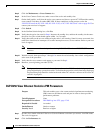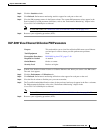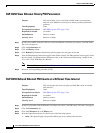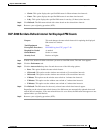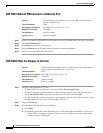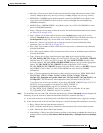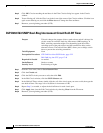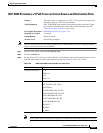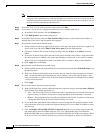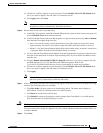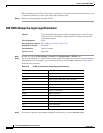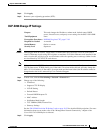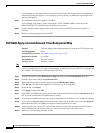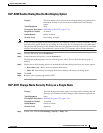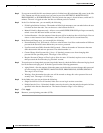
19-70
Cisco ONS 15454 SDH Procedure Guide, R7.2
October 2007
Chapter 19 DLPs D200 to D299
DLP- D264 Provision a J1 Path Trace on Circuit Source and Destination Ports
Note If neither port is on a transmit/receive card, you will not be able to complete this procedure. If
one port is on a transmit/receive card and the other is on a receive-only card, you can set up the
transmit string at the transmit/receive port and the receive string at the receive-only port, but you
will not be able to transmit in both directions.
Step 4 Choose the VC3 or VC4 circuit you want to trace, then click Edit.
Step 5 If you chose a VCAT circuit, complete the following. If not, continue with Step 6.
a. In the Edit Circuit window, click the Members tab.
b. Click Edit Member and continue with Step 6.
Step 6 In the Edit Circuit window, click the Show Detailed Map check box at the bottom of the window. A
detailed map of the source and destination ports appears.
Step 7 Provision the circuit source transmit string:
a. On the detailed circuit map, right-click the circuit source port (the square on the left or right of the
source node icon) and choose Edit J1 Path Trace (port) from the shortcut menu.
b. Choose the format of the transmit string by clicking either the 16 byte or the 64 byte selection
button.
c. In the New Transmit String field, enter the circuit source transmit string. Enter a string that makes
the source port easy to identify, such as the node IP address, node name, circuit name, or another
string. If the New Transmit String field is left blank, the J1 transmits a string of null characters.
d. Click Apply, then click Close.
Step 8 Provision the circuit destination transmit string:
a. On the detailed circuit map, right-click the circuit destination port and choose Edit Path Trace from
the shortcut menu.
b. In the New Transmit String field, enter the string that you want the circuit destination to transmit.
Enter a string that makes the destination port easy to identify, such as the node IP address, node
name, circuit name, or another string. If the New Transmit String field is left blank, the J1 transmits
a string of null characters.
c. Click Apply.
Step 9 Provision the circuit destination expected string:
a. In the Circuit Path Trace window, enable the path trace expected string by choosing Auto or Manual
from the Path Trace Mode drop-down list:
• Auto—The first string received from the source port is automatically provisioned as the current
expected string. An alarm is raised when a string that differs from the baseline is received.
• Manual—The string entered in Current Expected String is the baseline. An alarm is raised when
a string that differs from the Current Expected String is received.
b. If you set the Path Trace Mode field to Manual, enter the string that the circuit destination should
receive from the circuit source in the New Expected String field. If you set Path Trace Mode to Auto,
skip this step.
c. Click the Disable AIS and RDI if TIM-P is detected check box if you want to suppress the AIS
and remote defect indication (RDI) when the VC3 or VC4 High-Order Path Trace Identifier
Mismatch (HP-TIM) or Low-Order Path Trace Identifier Mismatch (LP-TIM) alarm appears. Refer
to the Cisco ONS 15454 SDH Troubleshooting Guide for descriptions of alarms and conditions.



